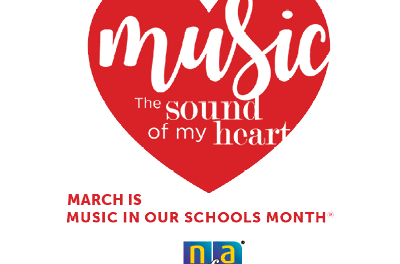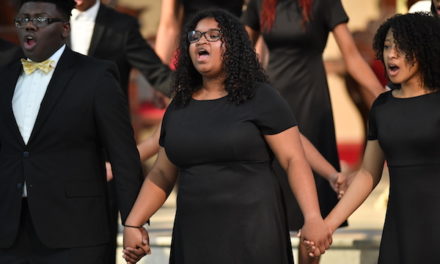“A global pandemic is not the way you’d want to force music education to modernize,” explains Philip Brown, choral director at Jefferson High School in Bloomington, Minn. “But the new tools we’re using may prove very engaging.”
COVID-19 has caused profound changes to school music programs, with technology taking on elevated importance. Tools like videoconferencing, interactive software and Wenger’s active acoustic technology are helping music educators survive and even thrive in dynamic circumstances.
Love of Music Motivates
Through these challenging times, the love of music and music-making keeps educators and students motivated. After the spring 2020 shutdown and summer vacation, a variety of learning models are in place this fall. More than 70 percent of music educators Wenger surveyed indicated rehearsals had resumed, with distancing modifications. However, nearly half the districts were undecided about the future of performances. Whatever the circumstances, affection for music – its creation and appreciation – is a common, unifying bond.
For example, the desire to perform just one minute of a Mozart string quartet inspired orchestra students at Wayzata High School in Plymouth, Minn., — in a modified hybrid model this fall – to accomplish this remote feat using the free Acappella app. The four students layered their parts together, creating a basic sense of ensemble music-making that satisfied their longing while “really challenging them” and raising their level of personal accountability to each other, according to their director, Mark Gitch.
Gaining Empathy & Choices
Altered expectations are also stretching music educators, while fostering their greater understanding and creativity in engaging students.
“Certainly I’ve learned a lot of things not to do,” says Matt Weidner, band director at Gunnison Valley High School in Gunnison, Utah. “I’ve become more empathetic to different types of family situations, realizing that not everyone’s in the same boat. Each person’s facing different kinds of stress with themselves, their homes and families.”
Choir director Michael Gutierrez at Firebaugh High School, Firebaugh, Calif., initially considered the pandemic as a threat to his program’s survival. “This fall I realized I needed to focus on the social and emotional learning of my students and individual music-making,” he says.
Gutierrez accepted that some students did not want to sing at home, or may not feel comfortable doing so. To keep students engaged, he surveyed them about musical skills they wanted to learn besides singing. After considering their input, he let them choose from four paths: 1) Digital music with Soundtrap online software; 2) Songwriting using Soundtrap and Google Docs; 3) Keyboard, using extra keyboards the school had; and 4) Voice, for students who wanted to focus on singing. He concludes, “I wanted my students to have useful experiences expressing themselves through their own music making, while keeping them emotionally connected to the program.”
Shifting Expectations, Motivation
As today’s educators modify their expectations, they’re also shifting lesson delivery. Teaching via videoconferencing is “far from optimal” according to Gitch. “We will cover less content with fewer performance opportunities, but what we can teach, we can teach pretty well.”
Varying internet speeds make creating an ensemble sound impossible. Rather, the focus is more on individual attention, which Gitch considers one benefit. “Last spring’s one-on-one lessons over Zoom exposed a lot of students — for not understanding rhythm, for example,” he recalls.
“Recording yourself to self-assess is one thing, but it’s completely different to record yourself for a duet, knowing someone else is relying on your accuracy,” says Gitch. Students use apps like Acapella or GarageBand for these assignments. He believes that this realization — “I’m not quite as good as I thought I was” – positively motivated all his students.
Enabling Self-Direction
For Weidner’s highly motivated students, tools like SmartMusic and Essential Elements Interactive enabled them to greatly accelerate their own personal development during the shutdown. “Those who worked hard online last spring developed into really fine musicians,” he states, adding that some likely finished last school year stronger on their own, without peers holding them back.
To inspire students to practice, band director Natalia Albacete at West Lake Middle School in Humble, Texas, likes Tonara software, which is installed on each student’s computer or smart phone. Tonara listens to them practicing; students earn points based on how long they’re actually playing. A customizable leaderboard tracks students’ practice times; she awards prizes to high performers. “The system creates a nice community and lots of competition for my students; it’s pretty cool,” comments Albacete. Tonara compares simple student recordings to an uploaded teacher example and provides feedback about alignment with the metronome and tone accuracy.
Developing Potential
A number of other tools – both new and updated – are helping music educators. Brown’s students each recently received a Music First account, which includes various software. “It’s helping us maintain four essential elements: vocal warmups, sight reading, music enrichment and also rehearsing a few songs,” he explains. Brown believes the website has great potential for tracking individual progress and engaging students, better enticing them to learn and stay focused.
Weidner is using Essential Elements Interactive for his middle school beginners, featuring professionals playing the parts in the students’ method books. There are 5-6 different background accompaniments – piano, pop, reggae, etc. – so students experience playing different music styles.
He also uses the same Canvas online learning platform from graduate school several years earlier. “We can easily set up recordings for the students to turn in on Canvas,” Weidner explains. “If the kids need to hear a recording of us playing, I can post a recording online so all the students can evaluate it.”
Game-Changing Acoustical Tool
For these teachers, another tool is proving helpful: Wenger’s virtual acoustic technology. Installed in a rehearsal space or practice room, it can electronically simulate nine different performance environments, helping accelerate student learning and concert preparation.
“This technology helps teach my students that every environment requires a different kind of performance,” says Jacquelyn Vondette, choir director at West Lake Middle School. Whether a vocal musician or instrumentalist, students hone their critical-listening skills while learning to balance and blend their sound with other musicians in the ensemble.
Under today’s hybrid’s learning models, having an acoustically supportive rehearsal space is especially valuable with fewer students in school. “In high school choirs, there’s power in numbers, says Kalle Akkerman, choir director at Austin High School, Austin, Minn. The fewer students he has in class, the more timid they are as singers.
By bolstering the sound, the Wenger active acoustic system provides more confidence to smaller groups that aren’t necessarily comfortable singing alone. “Now it’s like everyone is singing in their own personal shower,” he notes. System microphones pick up any sound in the room, modify it using digital signal processing technology and broadcast it through the array of speakers in the walls and ceiling – all in real time.
With digital record and playback capabilities, the Wenger active acoustic system also helps create a full ensemble sound that’s not physically possible due to the pandemic, scheduling conflicts, or any other reason.
“Now we can combine our beginner band classes without physically combining them,” explains Tami Goss, band director at Bridge City High School in Bridge City, Texas. “We record different instrument sections, like trumpets and clarinets together, and other sections play along later. This makes concert preparation much easier and I think our concerts turn out better too.”
Listening to Learn
Along with enabling larger-group “virtual rehearsals”, the integrated digital record/playback capability offers other important benefits such as enabling immediate feedback and self-critique.
“Self-assessment is one of the big analytical concepts we’re working on,” explains Vondette. “As teachers, our goal is for students eventually not to need us – to develop their own skills. Being able to listen to themselves through a high-quality system helps build that part of their brain and analytical ability.”
Her students love the instant gratification of hearing themselves perform and are able to tune and adjust as needed. “I can tell them all day and night: Your vowels need to be taller, Your breath support needs to be stronger, and other concepts,” Vondette adds. “But if they don’t hear the difference, they’re not going to adapt.”
Even before Wenger’s Virtual Acoustic Environment (VAE®) technology was adapted for large rehearsal or performance spaces, it was first developed for individual practice rooms. The patented technology can be incorporated in Wenger’s modular, reloctable Soundlok® Sound-Isolation Rooms or even retrofit into existing built-in practice rooms, called a Studio VAE® system.
Recordings of individual practice sessions or ensemble rehearsals can be easily downloaded for online distribution to students, to support their at-home practice. Finally, the technology’s key benefits also help satisfy the National Music Standards for K-12 education, related to students’ ability to create, perform and respond to music.
Anticipating Creativity
As everyone eagerly anticipates a “new normal” in music education and society overall, Akkerman is also looking ahead to the creativity these unusual times will likely inspire.
“Technology has helped us be together, and also to make and share music, but what kind of music is being created now?” he wonders. “All music is a reflection of a time and place. In ten years, I will be excited to look back at what’s come out of the pandemic; I’m sure people will still be writing music about this time.”



